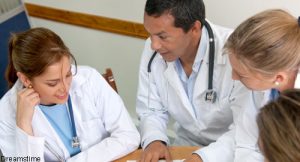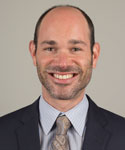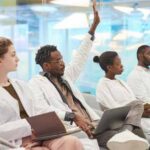 ORLANDO—“See one, do one, teach one” is the adage many physicians recall from their medical school and residency days. Although this pithy summary of the learning process seems straightforward, advances in our understanding of how to increase the effectiveness of medical education have transformed the way we instruct trainees. At the 2022 ACR Education Exchange, April 28–May 1, this topic was highlighted in a session focusing on evidence-based tools designed to improve the learning experience for rheumatology fellows.
ORLANDO—“See one, do one, teach one” is the adage many physicians recall from their medical school and residency days. Although this pithy summary of the learning process seems straightforward, advances in our understanding of how to increase the effectiveness of medical education have transformed the way we instruct trainees. At the 2022 ACR Education Exchange, April 28–May 1, this topic was highlighted in a session focusing on evidence-based tools designed to improve the learning experience for rheumatology fellows.
Jonathan Hausmann, MD, assistant professor of medicine, Beth Israel Deaconess Medical Center, Boston, began his lecture describing two emotions: excitement from attending his first ACR national meeting in 2011 and dismay in failing to recall most take-home points from the nearly 40 hours of lectures he attended. The experience left him wanting to know more about cognitive learning theory. And just as evidence-based medicine has evolved over the past 20 years, so too has evidence-based learning.
The concept of active learning describes how learners are taught knowledge and skills while thinking about the things they are doing to absorb that information. In a meta-analysis of 225 studies evaluating the performance of undergraduate students in science, technology, engineering and mathematic courses using traditional lecturing vs. active learning, Freeman et al. found active learning improved test scores and decreased failure rates compared with traditional lectures.1 Similarly, a Cochrane Review of continuing medical education meetings and workshops showed that mixed interactive and didactic education meetings were more effective than either didactic meetings or interactive meetings alone for improving professional practice and healthcare outcomes.2
The Study
Despite this data, lectures are the main mode currently used to teach basic science and clinical research skills to rheumatology fellows. This fact prompted Dr. Hausmann and colleagues to explore how active learning could be better incorporated into rheumatology fellowship didactics. The initiative focused on the introductory lectures new rheumatology fellows typically receive when they begin their fellowships.
In the first year of the project, Dr. Hausmann and colleagues observed trainees while they received traditional lectures, and each lecture was graded on its use of active learning techniques. Components of the score included such items as retrieval practice (i.e., using periodic questions during the lecture to revisit key concepts), elaboration (i.e., asking learners to explain their reasoning with follow-up questions or using hypothetical situations as the basis for discussion) and reflection (i.e., asking learners to identify or share with a neighbor key take-home points). At baseline, the average active learning score for these lectures was 8 on a scale of 0–24, with 24 being the highest degree of active learning.
Next, Dr. Hausmann and colleagues implemented an intervention in the form of a one-hour faculty development workshop designed to increase active learning via a flipped classroom approach. This approach involved learners receiving a pre-lecture assignment with required reading of an article or chapter prior to the lecture. At the time of the lecture, faculty would serve as guides to learners while they completed interactive cases. Classroom time was devoted to inquiry, application and assessment. At the end of the lecture, the faculty member would give each learner a recommended assignment to help consolidate the learning.
In a published article on this project, the intervention of the faculty development workshop increased the average active learning score for lectures and led fellows and faculty to report a largely positive experience with the process and outcomes. Faculty did note that they spent about one to two extra hours preparing their PowerPoint presentations to ensure these lectures were geared toward active learning. Nevertheless, faculty satisfaction with the process remained high.3
With some evidence emerging that the flipped classroom concept may work for increasing engagement and the success for learners, it’s worth asking why this may be the case. One positive element of the flipped classroom is the concept of retrieval, namely the way in which trainees must remember what they have learned prior to the lecture and apply the knowledge to teaching cases in real time. This process requires not just rote memorization of facts, but rather, the learning of facts followed by a process of self-assessment that challenges the learner to retrieve that knowledge in a practical manner.
When compared with traditional lectures, research has shown active learning improved test scores and decreased failure rates.
Improving Lectures
Dr. Hausmann explained that even traditional lectures can benefit from incorporating elements that spur active learning and improve retention of knowledge for trainees. He noted that faculty can use the four-question technique, which asks:
- What one important concept, research finding, theory or idea did you learn?
- Why do you believe this concept is important?
- How does what you learned apply to some aspect of your life?
- What questions has this activity raised for you, and what are you still wondering about?
Faculty can ask learners to generate their own questions after lectures and use these questions to test their fellow trainees.
For questions asked by faculty to trainees, Dr. Hausmann stated that not all questions are of equal value. Example: Questions that require a trainee to remember a discrete fact (e.g., What is the most common cause of uveitis?) are not as helpful as questions that require learners to analyze (e.g., How would the treatment plan differ if the patient had an active malignancy?), evaluate (e.g., What is the evidence to support your treatment plan?) or create (e.g., Based on the pathophysiology of rheumatoid arthritis, how would you design a new medication to decrease synovitis and improve patient outcomes?).
More generally speaking, Dr. Hausmann noted that learning requires effort, and mounting evidence suggests the more effort that is put into active, engaged learning, the more likely this effort is to yield effective outcomes for trainees.
The session left audience members with a great deal of food for thought, and perhaps that was exactly the point. If a lecture can challenge the listener to question, create and apply new ideas, then that may be the best sign of truly effective education.
Jason Liebowitz, MD, completed his fellowship in rheumatology at Johns Hopkins University, Baltimore, where he also earned his medical degree. He is currently in practice with Skylands Medical Group, N.J.
References
- Freeman S, Eddy SL, McDonough M, et al. Active learning increases student performance in science, engineering, and mathematics. Proc Natl Acad Sci U S A. 2014 Jun 10;111(23):8410–8415.
- Forsetlund L, Bjørndal A, Rashidian A, et al. Continuing education meetings and workshops: Effects on professional practice and health care outcomes. Cochrane Database Syst Rev. 2009 Apr 15;2009(2):CD003030.
- Wade SD, Freed JA, Kyttaris VC, et al. Implementing a virtual flipped classroom in a rheumatology fellowship program. Arthritis Care Res (Hoboken). 2021 Sep 22. Online ahead of print.



